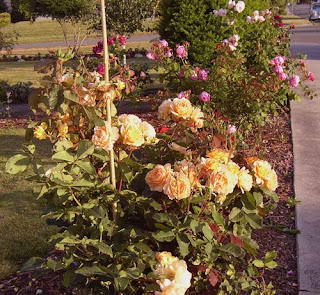
With all of the focus these days on organic gardening, "green" technologies, and protecting the environment, I thought I'd post a little something on certifying your garden as a wildlife habitat through the
National Wildlife Federation. It's easy to do and I don't think there's anything better than kicking back with a cup of coffee and watching birds and critters as they enjoy our gardens, too.
The first step toward certifying your garden is to provide birds and animals with the things they need most: food, water, shelter, and a place to raise their young. Just as important is avoiding the use of chemical fertilizers, herbicides, or pesticides. With compost, fish fertilizer, neem oil and insecticidal soap, I am able to feed and protect the garden while feeding and protecting the wildlife I've invited to be here.
Food sources include seeds, nuts, berries, nectar, and native plants. In my yard, I provide two bird feeders and use a wild bird seed mix that includes sunflower seeds. The small birds (sparrows and finches) eat the small seed and toss the sunflower seed to the ground for the squirrels. I also provide two nectar feeders for the hummingbirds and butterflies. Most summers I have an abundance of apples, plums, black currants, raspberrries, and blueberries that I don't mind sharing. So far, no one has been a glutton so they leave enough for me to eat and freeze.

I provide two sources of fresh water. There's a small pond with a fountain and a small concrete birdbath placed near the bird feeders. The birds and squirrels use both. The raccoons, neighborhood cats, and frogs prefer the pond. I am careful to keep the birdbath clean and filled daily with fresh water.
Shelter and a place to raise young are both provided by dense shrubs and trees for nesting. Over the years I've had sparrows, robins, and finches build nests in the garden. While I'm not sure where the squirrels are giving birth, I do have a couple of mama's who bring their young as soon as they're ready to forage for food.

The sparrow fledglings follow mom to the feeders, but still insist on being fed. My DH caught this photo this past week.
There's been a few surprise visitors to my garden - some that I'd rather wouldn't make it a habit to stop by. The little brown rabbits are adorable, but hard on the vegetable garden. Wiley C. Coyote wants to make a meal of the other critters, including my pet cat. And, the blue herons will eat every fish and frog in the pond if I don't shoo him away. I try to remind myself that we all have our place in the food chain. Even so, I keep a protective eye on the cat.
The most unusual visitor so far is this guy...

Pheasants are seldom seen here on the island and I've
never seen one taking a stroll down the sidewalk on a city street. This one walked through the front yard and around to the backyard where he made a bee-line for the seed on the ground beneath the feeders. It was like he knew exactly where to go. Now, I wonder who told him about my garden?
 Isn't that just crazy? I have two branches on this bush producing these harlequin style blooms. Even stranger, some of these blooms have petals with the 1/2 and 1/2 coloring - sometimes bright pink and white, sometimes bright pink and pale pink. Check it out:
Isn't that just crazy? I have two branches on this bush producing these harlequin style blooms. Even stranger, some of these blooms have petals with the 1/2 and 1/2 coloring - sometimes bright pink and white, sometimes bright pink and pale pink. Check it out: Imagine a rose whose blooms were entirely made up of 1/2 and 1/2 petals or one that always produced the half white, half pink blooms like the one at the top left in the photo above. I'd certainly buy a rose like that, wouldn't you?
Imagine a rose whose blooms were entirely made up of 1/2 and 1/2 petals or one that always produced the half white, half pink blooms like the one at the top left in the photo above. I'd certainly buy a rose like that, wouldn't you?



























